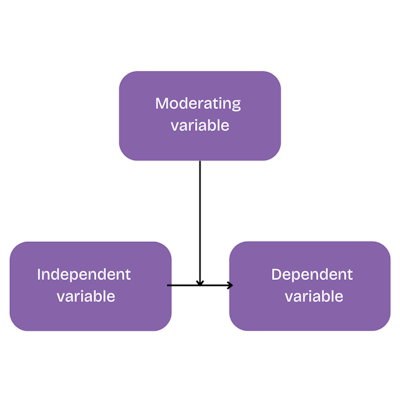05 May 2024
Tips for drawing up a good conceptual model
Drawing up a conceptual model can be a challenge for many students, especially because it is often introduced for the first time when writing a thesis. In this article, we will explain the meaning of a conceptual model and provide tips on how you can easily create one.

What is a conceptual model?
A conceptual model, also known as a conceptual framework, is a visual representation of the anticipated cause-and-effect relationship in your research. It serves as a depiction of the research questions or hypotheses in your thesis. A conceptual model provides clarity and an overview by illustrating the essence of your research. It is developed during the design phase of the research, prior to the initiation of the actual study.
When do you use a conceptual model?
Whether a conceptual model is useful for your thesis depends on the type of research you are conducting. Typically, a conceptual model is employed in testing research or when studying relationships or differences among variables. In testing research, the objective is to establish a causal relationship between different variables.
What are independent and dependent variables?
A cause-and-effect relationship always involves two types of variables: independent and dependent variables. The independent variable is the one that influences the dependent variable, with the independent variable being the cause and the dependent variable being the effect. Identifying these variables and incorporating them into a conceptual model is an important step in designing your research.

Example: Influence of study time on exam results
Independent and dependent variable
- Independent Variable: The independent variable is the factor that is manipulated and controlled in your study. In this example, the independent variable is “study time.” The researcher can manipulate the study time by assigning different amounts of study time to different groups of students - for instance, one group studying for 2 hours and another group studying for 4 hours.
- Dependent variable: The dependent variable is the result or outcome that is measured in response to changes in the independent variable. In this example, the dependent variable is the students’ “exam results.” These results are influenced by the amount of study time each group had. For instance, the researcher measures the exam scores of each group of students after they have had varying amounts of study time.
In this example, the independent variable, study time, is the factor that is being controlled and manipulated, while the dependent variable, exam results, is influenced by the changes in the independent variable.
Moderating variable
A moderating variable is a variable that modifies the strength or direction of the relationship between the independent variable and the dependent variable. For instance, in the context of the impact of study time on exam results, a potential moderating variable could be “study skills.”
Hypotheses
Based on this, we can formulate various hypotheses based on the specific focus of the research. Here are several potential hypotheses:
- Study skills moderate the relationship between study time and exam results.
- Increased study time leads to improved exam results, particularly for students with lower study skills.
- The impact of study time on exam results is mediated by study skills.
These hypotheses can be tested in a study to gain a better understanding of the relationships between the variables described in the text.
How do you create a conceptual model?
A conceptual model can be created using various graphic software or even by hand. Here’s a simple explanation of how you can create a conceptual model:
- Determine the variables: Firstly, identify the variables that are relevant to your research. This includes the independent variable(s), the dependent variable(s), and any moderating or mediating variables.
- Create a chart: Start by creating a chart where you place the variables. This can be a simple diagram with arrows showing the relationship between the variables.
- Add the variables: Place the independent variable(s) on one side of the chart and the dependent variable(s) on the other side. Use arrows to indicate the direction of the relationship, with the arrow starting at the independent variable and ending at the dependent variable.
- Consider moderating or mediating variables: If you have any moderator or mediator variables, add them to the diagram and show their relationship to the other variables.
- Labeling: Don’t forget to label each element of the diagram, including the variables and the arrows that indicate the relationships. This helps to understand the model clearly and easily.
Which program can I use to create a conceptual model?
There are numerous graphical software tools available for creating a conceptual model.
- Microsoft PowerPoint provides an easy way to create diagrams and visual models. It has features for creating shapes, lines, and text boxes that can be used to draw a conceptual model.
- Microsoft Visio is specifically designed for creating diagrams, including conceptual models. It offers a wide range of templates and shapes that can be used to create different types of models.
- Lucidchart is an online platform for creating diagrams and visual models, offering collaboration capabilities and an intuitive interface for creating complex conceptual models.
- Draw.io is a free online tool that enables you to create diagrams and conceptual models.
Need help with drawing up your conceptual model?
Sometimes, it can be challenging to identify the correct variables and formulate hypotheses, especially in multi-variable research. Our thesis coaches can assist you in clarifying your research questions, developing hypotheses, and shaping your conceptual model based on the chosen theories and literature. Please feel free to contact us for a complimentary consultation to determine the most suitable supervisor for you and to explore how we can provide support.
Do you want immediate help? Make an appointment now for a free consultation.
Contact Jouw Scriptiecoach if you need immediate help with your thesis.
Do you need immediate help with your thesis? Then request a free consultation now. During the consultation, we look at how best we can help you and which supervisor would be most suitable for your subject. You’ll also receive an immediate estimate of the number of hours we’ll need to get you across the finish line. Then you can easily purchase the hours online, and once the payment has gone through, we immediately connect you to your thesis supervisor. They’ll contact you quickly (often on the same day) so that you can get back to working on your thesis as soon as possible.
 NL
NL

